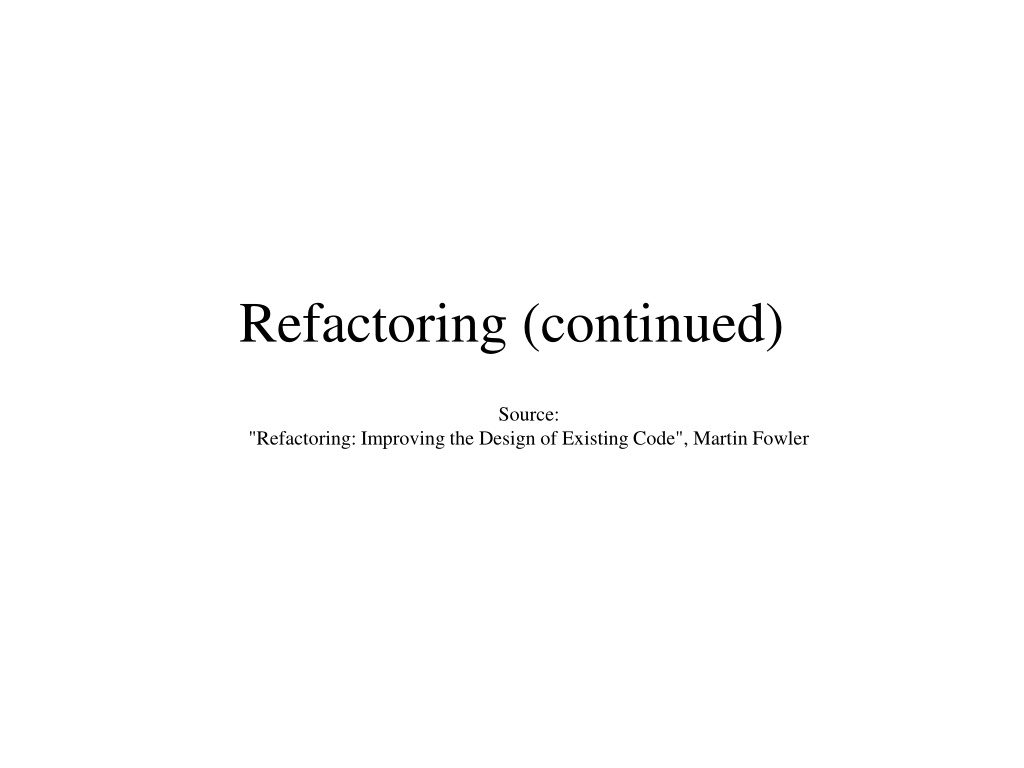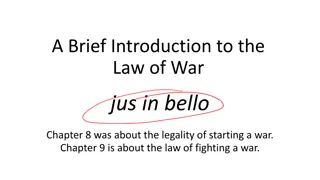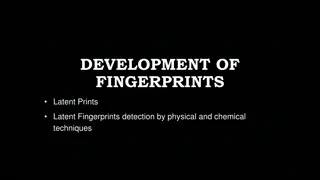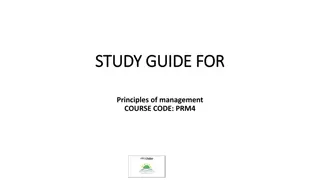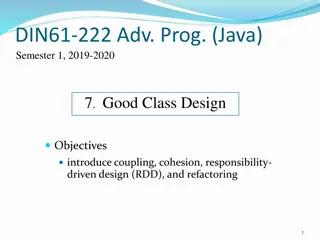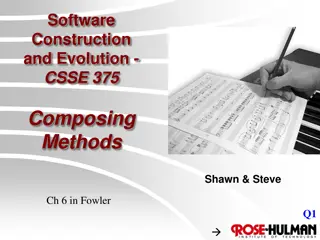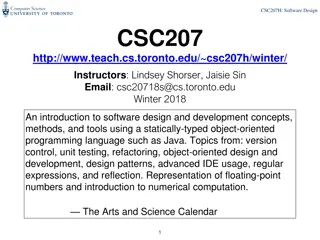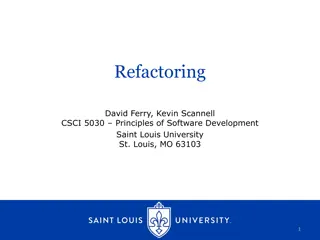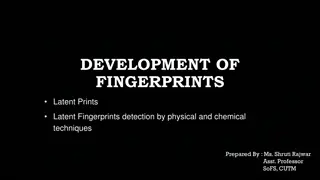Refactoring Principles and Techniques
In this collection of resources sourced from "Refactoring: Improving the Design of Existing Code" by Martin Fowler, you will learn about effective refactoring methods, a catalog of refactoring examples including introducing parameter objects, recognizing when to refactor based on code "smells" such as duplicated code and temporary fields, and strategies for addressing these issues like Extract Method and Temporary Field. Refactoring plays a crucial role in maintaining and improving the quality of software codebases.
Download Presentation

Please find below an Image/Link to download the presentation.
The content on the website is provided AS IS for your information and personal use only. It may not be sold, licensed, or shared on other websites without obtaining consent from the author.If you encounter any issues during the download, it is possible that the publisher has removed the file from their server.
You are allowed to download the files provided on this website for personal or commercial use, subject to the condition that they are used lawfully. All files are the property of their respective owners.
The content on the website is provided AS IS for your information and personal use only. It may not be sold, licensed, or shared on other websites without obtaining consent from the author.
E N D
Presentation Transcript
Refactoring (continued) Source: "Refactoring: Improving the Design of Existing Code", Martin Fowler
Effective Refactoring Knowing what refactorings are available Knowing when to apply them
Refactoring Catalog Example: Introduce Parameter Object
Knowing When to Refactor If it stinks, change it. Grandma Beck, discussing child-rearing philosophy
Bad Smells in Code (Signs that you need to refactor) Duplicated code Long method Large class Long parameter list Divergent change Shotgun surgery Feature envy Data clumps Primitive obsession Switch statements Parallel inheritance hierarchies Lazy class Speculative generality Temporary field Message chains Middle man Inappropriate intimacy Alternative classes with different interfaces Incomplete library class Data class Refused bequest Comments
Duplicated Code The same code structure is duplicated in multiple places Identical sections of code Similar sections of code (e.g., methods with similar structures) Hard to maintain, serious design problem Same Class => Extract Method Sibling Classes => Extract Method, Pull Up Method Similar Code In Sibling Classes => Form Template Method Unrelated Classes => Extract Class, all classes invoke the new class Unrelated Classes => Extract Method in one class, make other classes call its method
Temporary Field A class has one or more fields (i.e., variables) that are not used all the time Trying to understand why and when these fields aren't set is confusing Example: Some instances have a particular attribute, some don't E.g., Employee class with hourlyRate field that is used only for some employees Missing subclass. Use Extract Subclass to push conditional attributes into appropriate subclasses (e.g., HourlyEmployee) E.g., Within a class, rather than passing values between methods through parameter lists, values are temporarily stored in object variables. These variables have meaningful values only when a particular method is running (undesirable) Replace Method with Method Object
Long Method Long methods are hard to understand and more prone to bugs Find parts of the method that naturally go together, and Extract Method Problem: How do the new sub-methods access the parameters and locals of the original method? Store the original method s parameters and locals in instance variables so all sub-methods can access them? No. This would cause the Temporary Field problem (fields that are not used all of the time) Parameters & locals of original method could be passed as parameters into sub-methods Often works, but sometimes leads to long parameter lists on sub- methods Could Introduce Parameter Object to shorten parameter lists
Long Method (cont.) If the long method is reallylong, or if the parameter lists on extracted sub-methods are too long, you can Replace Method with Method Object Put the original method and all of its extracted sub-methods on a new class Parameters & locals from the original method become instance variables on the new class, making them available to the extracted methods without passing parameters Instantiate method object when you need to execute the method, then throw it away
Large Class Signs that a class is doing too much and needs further decomposition Remove duplication using Extract Method If there's still too much code, find groups of related methods and Extract Class or Extract Subclass Doesn't use all of its instance variables all of the time Find groups of instance variables that are only used some of the time, and Extract Subclass or Extract Class Replace Method with Method Object
Long Parameter List Long parameter lists are hard to understand OO programming tends to make parameter lists shorter Methods can get the data they need from the host class, or by calling methods on object parameters Refactorings for reducing the number of parameters If the method can access a passed-in value in some other way, don't pass it in (Replace Parameter with Method) If several parameters are related, Introduce Parameter Object to reduce the number of parameters If callers extract multiple values from an object so they can be passed to a method, it might be easier to just pass in the whole object (Preserve Whole Object) Unless you don't want to couple the two classes
Divergent Change Divergent types of changes require modifications to the same class Class C must be modified when: We change to a different data persistence technology We change to a different UI implementation We change to a different networking protocol Indicates the class is not cohesive (performs multiple unrelated responsibilities) Aspects of a system that are unrelated and will evolve independently should be implemented in different classes ( Separation of Concerns ) Identify different areas of responsibility, and Extract Class to move each different responsibility to a new class
Shotgun Surgery Ideally, Every design decision or policy is implemented at only one place in the code Changing a design decision or policy requires modifying only one class (or a small number of classes) Example: We decide to move from MS SQL Server to Oracle database Example: We change our policy for handling database exceptions Shotgun Surgery - Making a particular kind of change requires making lots of little changes to many different classes Indicates a particular responsibility is spread throughout the system, and may need to be centralized in a single class Create one class to perform the responsibilities related to the change Use Move Method and Move Field to move functionality to the new class Use Aspect-Oriented Programming (AOP)
Feature Envy A method on one class makes heavy use of the features on another class Good OO design should package data together with the processes that use the data This is a sign that the method is on the wrong class Move Method can fix that If only part of the method is "envious", use Extract Method to isolate the envious code, and use Move Method to move it to the other class What if the method uses data from several classes? Put the method on the class that it's most intimate with Use Extract Method to isolate the sections of code that interact heavily with other classes, and use Move Method to move the new methods where they belong
Data Clumps If multiple data items appear together in lots of places, it's likely that a class is missing Create a new class that encapsulates the data clump Consolidate behavior that's related to the data clump on the new class Move Method Replace all occurrences of the data clump with instances of the new class E.g., simplify parameter lists using Introduce Parameter Object
Primitive Obsession Some data items seem so simple that we use primitive data types to represent them String name; String phoneNumber; int payGrade; Simple values like this tend to get more complicated over time You need logic for parsing them, formatting them, changing them in controlled ways, etc. Because the values are primitives, this logic is placed on other classes This often leads to code duplication and feature envy Use Replace Data Value with Object to provide a proper home for this code
Switch Statements Switch statements are a form of duplication Each switch hard-codes the list of cases Adding a new case requires changing all the switches Good OO design replaces switches on type codes with polymorphic method calls Superclass defines a common interface containing dynamically- bound methods for all behaviors that vary between subclasses Most code is written in terms of references to the superclass, and dynamically-bound method calls replace switch statements New subclasses can be added without modifying existing code We prefer to not touch code that already works
Switch Statements Use Extract Method to isolate switches on type codes Use Move Method to move new methods containing switches to the class containing the type code Use Replace Conditional with Polymorphism to get rid of switches Set up inheritance hierarchy, and move the code from each switch case to the appropriate subclass
Parallel Inheritance Hierarchies You have two or more isomorphic inheritance hierarchies Whenever you add a class to one hierarchy, you also have to add corresponding classes to the other hierarchies Example: You might have inheritance hierarchies for Domain objects Data access objects GUI editors Every time you add a new domain class, you also have to create a new data access class and a new editor class Results in duplication and shotgun surgery
Parallel Inheritance Hierarchies Solution? Collapse the parallel hierarchies into one hierarchy Example: One class represents the domain object, data access object, and GUI editor A new concept can be added by creating only one class But, we now have domain stuff, data access stuff, and GUI stuff combined on a single class Is this really an improvement? How does it affect cohesion and layering? Often parallel hierarchies allow for better separation of concerns, and should be used (i.e., lesser of two evils) Sometimes it's better to collapse the hierarchies into one Code generation tools can help solve this problem. You still have parallel hierarchies, but only one must be maintained manually E.g., Write tools that automatically generate the code for the data access and editor classes for a domain class
Speculative Generality "I think we might need the ability to do this kind of thing someday, so let's build in support for it now" Speculating on future needs is a tricky business, so building a lot of infrastructure for features you may never need is dubious Signs of speculative generality: Unused classes, methods, parameters Complicated inheritance hierarchies that serve no current purpose Levels of indirection that serve no current purpose Remove speculative generality by applying relevant refactorings Remove Parameter, Inline Class, Collapse Hierarchy, Remove Middle Man, etc.
Message Chains obj.getThat().getTheOther().getYetAnother().FinallyDoSomething() The client is coupled to the structure of the navigation If the intermediate object relationships change, so must the client Exposing delegates to clients is poor encapsulation Shorten the chain as much as possible Use Hide Delegate to hide any remaining delegates obj.FinallyDoSomething()
Middle Man There are two options for reusing code from another class: Inheritance: Inherit from the other class, thus acquiring its functionality Composition: Create an instance of the other class and delegate method calls to it. The delegating class acts as a "middle man" Inheritance is easier because any changes made to the superclass are automatically inherited by the subclass Composition allows control over which of the other class' features are exposed by the client class, but requires work to write the delegating methods If a middle man does a lot of simple delegation to another class, consider the following refactorings Remove Middle Man: provide accessor for delegate so that clients can call it directly (could be harmful to encapsulation) Replace Delegation with Inheritance to avoid the work necessary to write the delegating methods (but all features of the superclass will be exposed)
Inappropriate Intimacy Classes know too much about each other "Classes should follow strict, puritan rules" Hide implementation details behind a minimal public interface "Fragile Base Class" problem Subclasses depend on internal details of a superclass. Changes to the superclass break the subclasses Internal details should be hidden even from subclasses (private is better than protected) Replace Inheritance with Delegation
Alternative Classes with Different Interfaces Two classes have methods that do similar things, but they use different naming conventions Delete vs. Remove Initialize vs. Setup People create similar code to handle similar situations, but don't realize the other code exists (i.e., duplication) Use Rename Method, Add Parameter, Remove Parameter, etc. to make the two sets of methods consistent If the classes can be modified to share code, use Extract Class, Extract Method, etc. to remove duplication
Incomplete Library Class A library class lacks some needed functionality, but we can't refactor the class because we didn't write it, don't have the code, etc. Introduce Local Extension Make a subclass of the library class that has the additional functionality If the library class can't be subclassed (i.e., it's "final"), or you don't control creation of the objects, you'll have to use a wrapper instead of a subclass If your language supports it, write an extension method to extend the library class without subclassing or wrapping it (C# and Objective-C support this) Introduce Foreign Method Create a method on the client class with an instance of the library class as the first argument private static Date nextDay(Date arg) { } Works if only a few methods need to be added
Data Class A class containing only fields and possibly getters/setters for those fields a.k.a. "structure" or "dumb data holder" Data classes are often manipulated in too much detail by other classes Feature envy is common when data classes are used Use Encapsulate Field to encapsulate public fields Use Encapsulate Collection to encapsulate collection fields Use Remove Setting Method to protect read-only fields Look at what other classes are doing with the data class, and use Move Method to reduce feature envy If you can't move entire methods, use Extract Method first to isolate the envious code, and then move it to the data class using Move Method
Lazy Class Effective OO design often leads to lots of classes But, each class costs money to understand and maintain A good design has enough classes to fully decompose the system into cohesive units, but no more Too few classes is bad. So is too many. Lazy Class: A class that isn't doing enough to justify it's existence Prior functionality has been moved to other classes (Move Field, Move Method, etc.) You had plans for the class that never materialized Get rid of lazy classes Use Inline Class to move its functionality to another class Fold TelephoneNumber class into Employee class? Use Collapse Hierarchy to move its functionality to its superclass Collapse PartTimeStudent into Student superclass?
Refused Bequest A subclass wants to inherit only part of its superclass's functionality In order to disable unwanted functionality, the sublass overrides unwanted methods to throw UnsupportedOperationException or just "do nothing" The subclass doesn't fully support the superclass's interface, and so isn't really a subtype (i.e., subclass objects can't be substituted in place of the superclass) Solution 1 Use Replace Inheritance with Composition to allow reuse without establishing a subtyping relationship Solution 2 Create a new sibling class and use Push Down Method and Push Down Field to push all unwanted functionality into the sibling
Comments Comments are good, but sometimes they're used as an excuse for writing bad code Before commenting some code, ask if there is a way to write it more clearly so it doesn't need comments If you feel the need to comment a block of code, use Extract Method to move the code into its own method Pick a good name so it's clear what the method does (use Rename Method until you get it right) If a comment makes a statement about the program's state at a particular point, use Introduce Assertion to replace the comment with an assertion
